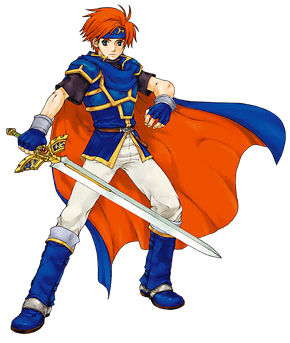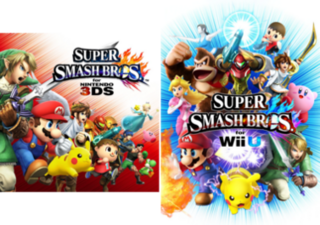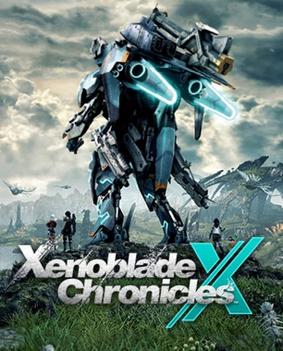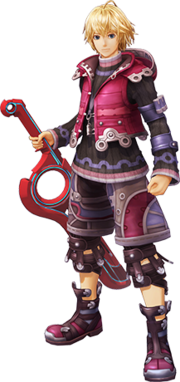
Roy is a fictional character from Nintendo and Intelligent Systems' Fire Emblem video game series, who first appeared in the 2001 crossover fighting game Super Smash Bros. Melee as a representative character from the Fire Emblem series, along with Marth. He is the lead character of Fire Emblem: The Binding Blade; within the story, he is the son of Eliwood and heir presumptive of Pherae, who eventually becomes a major military leader. The inclusion of Roy and Marth in Melee is cited as one of the reasons Nintendo started localizing the series for international distribution. Roy continues to make recurring appearances in subsequent Fire Emblem media, such as a manga series and spinoff video games.

Monolith Software Inc., trading as Monolith Soft, is a Japanese video game development studio originally owned by Namco until being bought out by Nintendo in 2007, best known for the Xenoblade Chronicles series of games. The company was founded in 1999 by Tetsuya Takahashi with the support and cooperation of Masaya Nakamura, the founder of Namco. Their first project was the Xenosaga series, a spiritual successor to the Square-developed Xenogears. Multiple Square staff would join Takahashi at Monolith Soft including Hirohide Sugiura and Yasuyuki Honne.
Tetsuya Takahashi is a Japanese video game designer, writer and director. Takahashi worked at Square in the 90s as a graphic designer and graphic director, participating on some of their most well-received titles such as Final Fantasy V, Final Fantasy VI and Chrono Trigger, before directing and co-writing Xenogears. He left Square in 1999 to co-found Monolith Soft, where he would develop the Xenosaga and Xenoblade Chronicles series with Namco and Nintendo respectively, being the executive director of Xenoblade since the first entry in the series.
Super Smash Bros. is a crossover platform fighting game series published by Nintendo. The series was created by Masahiro Sakurai, who has directed every game in the series. The series is known for its unique gameplay objective which differs from that of traditional fighters, in that the aim is to increase damage counters and knock opponents off the stage instead of depleting life bars.

Baten Kaitos Origins, released in Japan as Baten Kaitos II, is a 2006 role-playing video game developed by Monolith Soft and Tri-Crescendo for the GameCube. It is a prequel to Baten Kaitos: Eternal Wings and the Lost Ocean (2003). Similar to the first entry, the player assume the role of a "guardian spirit" – an unseen player avatar – who guides protagonist Sagi and his party of companions in an adventure across an aerial floating island-based kingdom in the clouds. The game retains the original's focus around the concept of "Magnus" – magical cards that capture the "essence" of items found in the in-game world, where the concept is still used as a plot device, for in-game item management, and as a basis for the card-themed battle system, albeit with minor tweaks.

Ike is a character from the Fire Emblem series of video games. He is the central protagonist and Lord-class character of the ninth game in the series, Fire Emblem: Path of Radiance, and one of the central characters in Fire Emblem: Radiant Dawn. Ike is one of the most popular characters in the Fire Emblem series, and has appeared in other media, most notably the Super Smash Bros. fighting game series.

Little Mac is a fictional boxer and the protagonist in Nintendo's Punch-Out!! series of video games. He first appeared in the Arcade game Punch-Out!!. He is the smallest and youngest of all the boxers in the games, being only 17 years old across all Punch-Out!! games. His signature attack is the "STAR Punch". His design was changed for the SNES Super Punch-Out!!, but reverted to his original design in the Wii title. In the NES and Wii games, Little Mac is accompanied by Doc Louis, his trainer.

Xenoblade Chronicles is an action role-playing game developed by Monolith Soft and published by Nintendo for the Wii. Initially released in Japan in 2010, it was later released in the PAL regions in 2011 and in North America in 2012. A port for the New Nintendo 3DS was released in 2015, and a remaster for the Nintendo Switch, titled Xenoblade Chronicles: Definitive Edition, was released in May 2020. Xenoblade Chronicles is the first entry in the Xenoblade Chronicles series, a subseries which forms part of the larger Xeno metaseries. Although it lacks direct narrative connections to previous Xeno games, like them, it incorporates aesthetic and narrative elements from both fantasy and science fiction. The game features navigation through an open world split into zones, side-quests tied to party members' affinity, and a real-time action-based battle system which incorporates Shulk's ability to see brief glimpses of the future.

Super Smash Bros. for Nintendo 3DS and Super Smash Bros. for Wii U, both commonly referred together as Super Smash Bros. 4, are 2014 crossover platform fighter video games developed by Bandai Namco Studios and Sora Ltd. and published by Nintendo for the Nintendo 3DS and Wii U video game consoles. It is the fourth installment in the Super Smash Bros. series, succeeding Super Smash Bros. Brawl. The Nintendo 3DS version was released in Japan on September 13, 2014, and in North America, Europe, and Australia the following month. The Wii U version was released in North America, Europe, and Australia in November 2014 and in Japan the following month.
Operation Rainfall, commonly known as oprainfall, was a video game-oriented fan campaign founded to promote the release of games not available in North America. Initially aimed at promoting the North American release of three games on the aging Wii home video game console only released in Japan and Europe, it later transitioned into a community blog dedicated to niche Japanese games and further fan campaigns aimed at the localization of Japan-exclusive games. From inception, its stated intention was to show publisher Nintendo the demand for the three chosen games.
Adam Howden is an English actor who has worked in video games, television, theatre, film, and audiobooks.

Xeno is a Japanese science fantasy video game franchise created by Tetsuya Takahashi. The first entry was developed by SquareSoft, and subsequent entries have been developed by Monolith Soft, a company founded by Takahashi after he left Square in 1999. While the various games have no direct story connections, they have common thematic links and all sport the "Xeno" prefix, which Takahashi has variously described as a means of identifying his games and a symbolic representation of the series. All the games in the Xeno meta series take place within a science fiction setting with some fantasy elements, with its stories frequently featuring psychological, philosophical, and religious themes.

Xenoblade Chronicles X is a 2015 action role-playing game developed by Monolith Soft and published by Nintendo for the Wii U console. The game is part of the Xenoblade Chronicles series, itself forming part of the wider Xeno metaseries. Carrying over several gameplay elements from the original game, players explore the open world planet Mira, completing a variety of quests and unlocking new regions to explore and gather resources from across its five continents. The story follows a surviving human ship after escaping an alien battle which destroys Earth, with the player character joining the BLADE unit to defend the human survivors and uncover Mira's secrets.

Lucina is a fictional character and one of the protagonists from Intelligent Systems's 2012 role-playing video game Fire Emblem Awakening, part of their overarching Fire Emblem series of video games. Her popularity later led to her inclusion in several other video games, including Intelligent System's 2015 title Code Name: S.T.E.A.M., Nintendo's crossover fighting game Super Smash Bros. for Nintendo 3DS and Wii U and its sequel Super Smash Bros. Ultimate, Capcom's Monster Hunter Frontier G, and Bandai Namco's crossover RPG Project X Zone 2. Lucina would again appear in future Fire Emblem titles as well, including Fire Emblem Fates, Fire Emblem Heroes, Fire Emblem Warriors, and Fire Emblem Engage though in more of a supporting role rather than a protagonist with the latter titles.
Lin Lee, full name Lin Lee Koo, is a fictional character from Monolith Soft's 2015 role-playing video game Xenoblade Chronicles X, part of their overarching Xeno series of video games.

Xenoblade Chronicles 2 is a 2017 action role-playing game developed by Monolith Soft and published by Nintendo for the Nintendo Switch. It is the third installment in the Xenoblade Chronicles series and the sixth main entry in the Xeno series, and was released on December 1. Plans for the game began shortly before the launch of Xenoblade Chronicles X in 2014. Key developers from previous games returned, including franchise creator Tetsuya Takahashi and directors Koh Kojima and Genki Yokota. The team wanted to develop a story-driven game in the style of the original Xenoblade Chronicles. The game was announced in 2017 and was released worldwide the same year. As with Xenoblade Chronicles, the game was localized by Nintendo of Europe.

Xenoblade Chronicles is a series of action role-playing games developed by Monolith Soft and published by Nintendo. The series began with the original Xenoblade Chronicles game, published for the Wii in 2010 in Japan, and released in Europe and Oceania the following year. Nintendo originally had no plans for a North American release, but after a fan campaign named Operation Rainfall showed sufficient interest, the game was eventually released in the region in 2012. The original game became a critical and commercial success, spawning multiple sequels. The series has since sold more than 8.74 million copies worldwide. Xenoblade Chronicles has been well-received for its world design, music, stories, and themes. The series has been represented in other gaming franchises, including the Super Smash Bros. and Project X Zone series. It is loosely a part of the Xeno metaseries, for which it receives its namesake, co-created and directed by Tetsuya Takahashi.

Xenoblade Chronicles 2: Torna – The Golden Country is a 2018 action role-playing game developed by Monolith Soft and published by Nintendo for the Nintendo Switch console. It is a story expansion to the 2017 game, Xenoblade Chronicles 2, and was released both as downloadable content and as a standalone title on a physical cartridge.

Xenoblade Chronicles 3 is a 2022 action role-playing game developed by Monolith Soft and published by Nintendo for the Nintendo Switch. It is an installment in the open-world Xenoblade Chronicles series, itself a part of the larger Xeno franchise. Xenoblade Chronicles 3 depicts the futures of the worlds featured in Xenoblade Chronicles (2010) and Xenoblade Chronicles 2 (2017) and concludes the trilogy's narrative.













